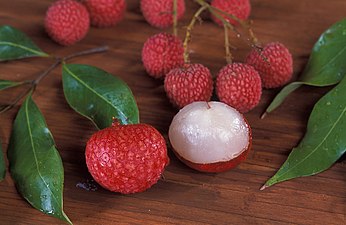Léci
| Léci | |
|---|---|

| |
| Léci sing mateng | |
| Klasifikasi ngèlmiah | |
| Karajan: | Plantae |
| Unranked: | Angiospermae |
| Unranked: | Eudikotil |
| Unranked: | Rosidae |
| Ordho: | Sapindales |
| Famili: | Sapindaceae |
| Génus: | Litchi Sonn. |
| Spésies: | L. chinensis |
| Jeneng binomial | |
| Litchi chinensis Sonn. | |

Léci minangka salah sawijining wit taunan saka kulawarga sapindaceae. Wit iki minangka wit tropis sing asale saka propinsi Guangdong lan Fujian, kidul-wetan China, ing endi budidaya didokumentasikake wiwit abad kaping 11. [1] China minangka penghasil utama lychees, disusul karo India, negara liya ing Asia Tenggara, Benua India lan Afrika Selatan . Wit ijo sing dhuwur, lchee ngasilake woh-wohan cilik . Sisih njaba woh-wohan jambon-abang, kanthi tekstur lan ora bisa dipangan, nutupi daging legi sing dipangan ing macem-macem panganan cuci mulut.
Wedharan
Leci ditandur kanthi wiyar ing China kidul, Taiwan, Vietnam lan sakiwa-tengene tropis Asia Tenggara, Benua India, [2] lan ing wilayah tropis ing pirang-pirang negara liyane. [3] [2] [4] Padha mbutuhake iklim tropis sing ora beku lan ora ngisor suhu −4 °C (25 °F) . [3] [2] Leci mbutuhake iklim sing panas banget, udan, lan asor ing musim panas, tuwuh kanthi optimal ing lemah sing lemes, rada asam kanthi bahan organik lan mulsa. [3] [2] Wiji Lychee ngemot methylene cyclopropyl glycine sing bisa nyebabake hypoglycemia digandhengake karo wabah encephalopathy ing bocah-bocah India lan Vietnam sing kurang gizi sing ngonsumsi buah lychee. [5] [6]
Udakara 200 kultivar ana, kanthi bentuk diwasa lan pungkasan wis cocog kanggo iklim sing luwih anget lan adhem, [7] sanajan umume wolung kultivar digunakake kanggo perdagangan ing Tiongkok. [8] Dheweke uga ditandur minangka wit hias, uga kanggo woh-wohan. [7] Cara nyebarake lychee paling umum yaiku kanthi metode sing disebut lapisan udara utawa marcotting. Lapisan udara, utawa marcotts, digawe kanthi motong cabang wit diwasa, nutupi potongan nganggo medium rooting, kayata gambut utawa lumut sphagnum, banjur bungkus medium nganggo film polietilen lan ngidini oyot bisa tuwuh. Sawise rooting signifikan, marcott dipotong saka cabang lan pot. [9]
Miturut folklore, wit lychee sing ora ngasilake akeh woh bisa diikat, nyebabake ngasilake woh luwih akeh. Nalika bukaan tengah wit ditindakake minangka latihan lan pruning, fruiting stereo bisa diasilake kanggo produktivitas kebon sing luwih dhuwur. [10] Lychees umume didol seger ing pasar Asia. [11] [12] Kulit abang dadi coklat tuwa nalika woh wis adhem, nanging rasane ora kena. Uga didol kaleng ing saindenging taun. Woh kasebut bisa dikeringake kanthi kulit sing utuh, ing wektu iku daging saya suda lan peteng. [13]
Gladri
-
Lèci wis diopèk
-
Wit lèci
-
Kembang léci
-
Léci disigar
Rujukan
Pratuduh rujukan
- ↑ Morton JF (1987). "Lychee in Fruits of Warm Climates". Center for New Crops & Plant Products, Purdue University, Department of Horticulture and Landscape Architecture, West Lafayette, Indiana. kc. 249–259. Dibukak ing 2013-10-30.
- ↑ a b c d SK Mitra (2000). "Overview of lychee production in the Asia-Pacific region". Food and Agricultural Organization of the United Nations, Office for Asia and the Pacific. Dibukak ing 12 June 2020.
- ↑ a b c Morton JF (1987). "Lychee in Fruits of Warm Climates". Center for New Crops & Plant Products, Purdue University, Department of Horticulture and Landscape Architecture, West Lafayette, Indiana. kc. 249–259. Dibukak ing 2013-10-30.
- ↑ Crane, Jonathan H.; Carlos F. Balerdi; Ian Maguire (2008) [1968]. "Lychee growing in the Florida home landscape". University of Florida. Dibukak ing 30 June 2009.
- ↑ "The enigma of litchi toxicity: an emerging health concern in southern Asia". The Lancet. Online, 30 January 2017 (4): e383–e384. 2017. doi:10.1016/S2214-109X(17)30046-3. PMID 28153516.
- ↑ Aakash Shrivastava; Anil Kumar; Jerry D Thomas; Kayla F Laserson; Gyan Bhushan; Melissa D Carter; Mala Chhabra; Veena Mittal; Shashi Khare (2017). "Association of acute toxic encephalopathy with lychee consumption in an outbreak in Muzaffarpur, India, 2014: a case-control study". The Lancet. 30 January 2017 (online) (4): e458–e466. doi:10.1016/S2214-109X(17)30035-9. PMID 28153514.
- ↑ a b Morton JF (1987). "Lychee in Fruits of Warm Climates". Center for New Crops & Plant Products, Purdue University, Department of Horticulture and Landscape Architecture, West Lafayette, Indiana. kc. 249–259. Dibukak ing 2013-10-30.
- ↑ SK Mitra (2000). "Overview of lychee production in the Asia-Pacific region". Food and Agricultural Organization of the United Nations, Office for Asia and the Pacific. Dibukak ing 12 June 2020.
- ↑ Menzel, C.M. (January 1985). "Propagation of lychee: A review". Scientia Horticulturae. 25 (1): 31–48. doi:10.1016/0304-4238(85)90074-3. ISSN 0304-4238.
- ↑ "Good management practices in litchi" (PDF). National Research Centre on Litchi, Bihar, India. 2016. Diarsip saka sing asli (PDF) ing 20 August 2021. Dibukak ing 24 November 2016.
- ↑ Morton JF (1987). "Lychee in Fruits of Warm Climates". Center for New Crops & Plant Products, Purdue University, Department of Horticulture and Landscape Architecture, West Lafayette, Indiana. kc. 249–259. Dibukak ing 2013-10-30.
- ↑ SK Mitra (2000). "Overview of lychee production in the Asia-Pacific region". Food and Agricultural Organization of the United Nations, Office for Asia and the Pacific. Dibukak ing 12 June 2020.
- ↑ Davidson, Jane L.; Davidson, Alan; Saberi, Helen; Jaine, Tom (2006). The Oxford companion to food. Oxford [Oxfordshire]: Oxford University Press. ISBN 978-0-19-280681-9.



